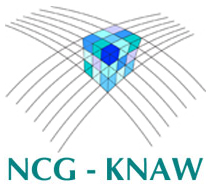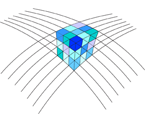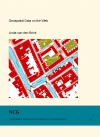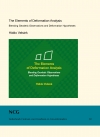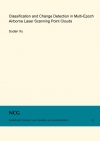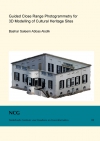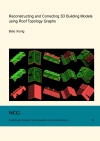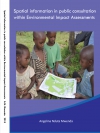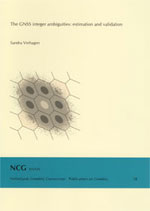
Sandra Verhagen
Publications on Geodesy 58, Delft, 2005. 194 pagina's.
ISBN-13: 978 90 6132 290 0. ISBN-10: 90 6132 290 1.
Summary
Fast and high precision relative positioning with a Global Navigations Satellite System (GNSS) is only possible by using the very precise carrier phase measurements. However, these carrier phases are ambiguous by an unknown number of cycles. The knowledge that the ambiguities are integer-valued has been exploited in the past 15 years for the development of integer ambiguity resolution algorithms. Once the ambiguities are fixed to their integer values, the carrier phase measurements start to act as if they were very precise pseudorange measurements.
The estimation process consists then of three steps. First a standard least-squares adjustment is applied in order to arrive at the so-called float solution. All unknown parameters are estimated as real-valued. In the second step, the integer constraint on the ambiguities is considered. This means that the float ambiguities are mapped to integer values. Different choices of the map are possible. The float ambiguities can simply be rounded to the nearest integer values, or conditionally rounded so that the correlation between the ambiguities is taken into account. The optimal choice is to use the integer least-squares estimator, which maximizes the probability of correct integer estimation. Finally, after fixing the ambiguities to their integer values, the remaining unknown parameters are adjusted by virtue of their correlation with the ambiguities.
Nowadays, the non-trivial problem of integer ambiguity estimation can be considered solved. However, a parameter estimation theory is not complete without the appropriate measures to validate the solution. So, fixing the ambiguities should only be applied if there is enough confidence in their correctness. The probability of correct integer estimation can be computed a priori - without the need for actual observations - and is called the success rate. Only if this success rate is very close to one, the estimated fixed ambiguities may be considered deterministic. In that case it is possible to define test statistics in order to validate the fixed solution. If the success rate is not close to one, in practice a user has to choose between two undesirable situations:
- Integer validation is based on wrong assumptions, since the randomness of the fixed ambiguities is incorrectly ignored;
- No attempt is made to fix the ambiguities because of the low success rate, although there is still a probability that the ambiguities can be fixed correctly.
Examples of integer validation tests proposed in literature, are the ratio test, the projector test, and the difference test. Some of these integer validation tests are defined such that the invalid assumption of deterministic fixed ambiguities is avoided. However, these tests lack a sound theoretical foundation. Moreover, often fixed critical values are used based on experience. But that implies that in many situations the tests will either be too conservative or too optimistic.
Obviously, validation of the integer ambiguity solution is still an open problem. In order to avoid the above two situations, two approaches are investigated here.
The first method uses a new ambiguity estimator, which is in some sense always superior to its float and fixed counterparts. This estimator is the Best Integer Equivariant (BIE) estimator. It is best in the sense that it minimizes the mean squared errors of the estimators. This is a weaker performance criterion than that of the integer least-squares estimator, the maximization of the success rate. This might be an advantage if the success rate is not high, since then a user would not use the fixed solution, but stick to the float solution. The BIE ambiguity estimator is equal to a weighted sum over all integer vectors, and the weights depend on the probability density function of the float ambiguities. Therefore, the BIE estimator can be considered as a compromise between the float and fixed solution; those are approximated in the extreme cases of very bad or very good precisions, respectively. The disadvantages of BIE estimation are that an exact probabilistic evaluation of the solution is still not possible, and the procedure is computationally complex. Moreover, it was shown that the BIE estimator significantly outperforms the float or fixed solution only in a limited number of cases.
Therefore, another new class of integer estimators is investigated: the class of Integer Aperture (IA) estimators. IA estimation is an overall approach of integer estimation and validation. This is the case because three a priori probabilities are distinguished: the success rate, the fail rate, and the undecided rate. Around each integer an identically shaped acceptance region, referred to as the aperture pull-in region, is defined, with the size determined by the choice of a maximum allowed fail rate. With respect to the shape of the regions different choices are possible. Examples are ellipsoids and scaled versions of the integer bootstrapping or integer least-squares pull-in regions. It is also shown that the acceptance regions corresponding to the ratio tests, the projector test and the difference test are examples of aperture pull-in regions. Finally, the optimal IA estimator is defined such that the success rate is maximized for a fixed fail rate.
IA estimation has several important advantages. The first is that it is an overall approach to the integer estimation and validation problem, which makes exact probabilistic evaluation of the final solution possible. Furthermore, the acceptance region is determined by the choice of the maximum allowed fail rate, which is exactly what a user wants. This means that the region depends on the model at hand, and thus on the precision. With the traditional approaches this is not the case, so that in general the tests are either too conservative or too optimistic. In the first case this leads to a unnecessarily long time to first fix, in the second case the fail rate will be unacceptably high.
Finally, it is shown that the popular ratio test and the difference test perform almost as good as the optimal IA estimator if the fixed fail rate approach is used. So, a theoretical justification is given for these tests, such that an appropriate choice of the critical values is possible. Also the IA least-squares estimator, based on using down-scaled integer least-squares pull-in regions, performs well. This estimator is identical to the integer least-squares estimator combined with integer hypothesis testing, but with the advantage that the acceptance region is determined by the choice of the fail rate and not by the false alarm rate.
Contents
- Preface
- Summary
- Samenvatting
- Notation and symbols
- Acronyms
- Introduction
- GNSS observation model and quality control
- Integer ambiguity resolution
- Best Integer Equivariant estimation
- Integer Aperture estimation
- Conclusions and recommendations
App. A. Mathematics and statistics
App. B. Simulation and examples
App. C. Theory of BIE estimation
App. D. Implementation aspects of IALS estimation
App. E. Curriculum vitae
- Bibliography
- Index
Samenvatting
Hoge precisie relatieve plaatsbepaling met behulp van een Global Navigation Satellite System (GNSS) is alleen mogelijk als de zeer precieze fasewaarnemingen van de draaggolf gebruikt worden. Helaas zijn deze fasewaarnemingen meerduidig, omdat niet gemeten kan worden hoeveel cycli er aan de waarneming zijn voorafgegaan. Wel is bekend dat de meerduidigheden geheeltallig zijn, en deze kennis is uitgebuit voor de ontwikkeling van algoritmes voor geheeltallige meerduidigheidsbepaling. Als de meerduidigheden eenmaal geschat zijn, kunnen de fasewaarnemingen beschouwd worden als zeer precieze pseudo-afstandsmetingen.
De schattingsprocedure bestaat dan uit drie stappen. Allereerst wordt er een standaard kleinstekwadratenvereffening uitgevoerd, resulterend in de zogenaamde float oplossing. Alle onbekende parameters worden in dit geval geschat als reëelwaardig. In de tweede stap wordt er gebruik gemaakt van de voorwaarde dat de meerduidigheden geheeltallig moeten zijn. Daarvoor kunnen verschillende schatters gebruikt worden. Het simpelst is om de float meerduidigheden af te ronden naar de dichtstbijzijnde geheeltallige waarden (integer rounding). Een andere mogelijkheid is om de meerduidigheden conditioneel af te ronden, zodat de correlatie van de meerduidigheden betracht wordt (integer bootstrapping). De optimale keuze is echter om de integer kleinstekwadraten schatter te gebruiken, omdat deze de kans op correcte geheeltallige schatting maximaliseert. Tenslotte, nadat de meerduidigheden bepaald zijn, worden de resterende parameters gecorrigeerd op basis van hun correlatie met de meerduidigheden. De uiteindelijke oplossing wordt de fixed oplossing genoemd.
Het niet-triviale probleem van geheeltallige meerduidigheidsschatting kan op dit moment als opgelost beschouwd worden. Echter, zonder geschikte maten om de schatting te valideren, is de oplossing nog niet compleet. De fixed meerduidigheidsoplossing mag alleen gebruikt worden als er genoeg vertrouwen is in de correctheid ervan. De kans op het correct schatten van de geheeltallige meerduidigheden kan a priori, dat wil zeggen zonder dat waarnemingen nodig zijn, berekend worden. Deze kans wordt de success rate genoemd. Alleen als de success rate zeer dichtbij één ligt, mogen de geschatte fixed meerduidigheden als deterministisch beschouwd worden. In dat geval is het mogelijk om toetsgrootheden te definiëren die validatie van de fixed oplossing mogelijk maken. Maar als de success rate te laag is, zal een gebruiker in de praktijk een keuze moeten maken tussen twee onwenselijke situaties:
Validatie van de geheeltallige oplossing gebaseerd op foute aannames, doordat de fixed meerduidigheden onterecht als deterministisch beschouwd worden;
Er wordt geen poging gedaan de meerduidigheden te bepalen omdat de success rate te laag is, terwijl er toch een kans bestaat dat de juiste geheeltallige oplossing gevonden zou worden.
Voorbeelden van integer validatietoetsen die in de literatuur zijn voorgesteld zijn de ratio-toets, de projectortoets en de verschiltoets. Sommige van deze integer validatie toetsen zijn zodanig gedefinieerd dat de foutieve aanname van deterministische fixed meerduidigheden wordt vermeden. Deze toetsen ontberen echter een goede theoretische basis. Bovendien worden vaak vaste kritieke waarden gebruikt die gebaseerd zijn op ervaring. Maar dat betekent dat in veel situaties de toetsen ofwel te conservatief ofwel te optimistisch zullen zijn.
In dit proefschrift is het onderzoek beschreven naar twee methodes om het geschetste probleem op te lossen.
De eerste methode betreft het gebruik van een nieuwe schatter, de zogenaamde best integer equivariant (BIE) schatter. Deze schatter maakt wel gebruik van de voorwaarde van geheeltallige meerduidigheden, maar niet op de optimale manier. De schatter is 'best' in de zin dat de mean-squared error (MSE) geminimaliseerd wordt. De BIE meerduidigheidsschatter is gelijk aan een gewogen som over alle integer vectoren, waarbij de gewichten afhankelijk zijn van de kansdichtheidsfunctie van de float meerduidigheden. De BIE schatter kan daarom beschouwd worden als een compromis tussen de float en fixed oplossing; deze worden benaderd in de extreme gevallen van respectievelijk oneindig slechte of oneindig goede precisie. Nadelen van BIE schatting zijn dat een exacte probabilistische evaluatie van de oplossing nog steeds niet mogelijk is, en dat de procedure nogal complex is en veel rekentijd vergt. Bovendien is aangetoond dat de BIE schatter slechts in een beperkt aantal gevallen tot duidelijk betere resultaten leidt dan de float of de fixed oplossing.
Daarom is ook onderzoek gedaan naar een andere nieuwe klasse van schatters: de klasse van integer aperture (IA) schatters. Hierbij zijn schatting en validatie geïntegreerd, doordat a priori drie kansen worden onderscheiden: de kans op correct fixen (success rate), de kans op foutief fixen (fail rate), en de kans op niet fixen (undecided rate). Rondom elke integer wordt een gelijkvormig acceptatiegebied (aperture pull-in region) gedefinieerd, waarbij de grootte bepaald wordt door de keuze van een maximaal toelaatbare fail rate. Met betrekking tot de vorm zijn verschillende keuzes mogelijk. Voorbeelden zijn ellipsoïdes en geschaalde pull-in regions (bootstrapping of integer kleinstekwadraten). Verder is aangetoond dat ook de acceptatiegebieden behorend bij de ratio-toetsen, de projectortoets en de verschiltoets voorbeelden zijn van aperture pull-in regions. Tot slot is de optimale IA schatter gedefinieerd zodanig dat voor een vaste fail rate de success rate wordt gemaximaliseerd.
IA schatting heeft belangrijke voordelen. Ten eerste is het een overall aanpak voor het integer schattings- en validatieprobleem, die tevens een exacte probabilistische evaluatie van de uiteindelijke oplossing mogelijk maakt. Verder wordt het acceptatiegebied vastgelegd door de keuze van de maximaal toelaatbare fail rate, precies wat een gebruiker wil. Dit betekent dat het acceptatiegebied afhangt van het model, en dus de precisie, waarmee op dat moment gewerkt wordt. Met de traditionele methodes is dat meestal niet het geval en zijn de toetsen ofwel te conservatief of te optimistisch. In het eerste geval leidt dat tot onnodig lange 'times to first fix', in het tweede geval zal de fail rate onacceptabel hoog zijn.
Tot slot is aangetoond dat de populaire ratio toets en de verschiltoets bijna net zo goed presteren als de optimale IA schatter indien de kritieke waarde wordt bepaald door de maximaal toelaatbare fail rate. Er is nu dus een theoretische basis beschikbaar voor het gebruik van deze toetsen, zodanig dat ook een correcte keuze van de kritieke waarde mogelijk is. Ook de IA kleinstekwadraten schatter, gebaseerd op het gebruik van geschaalde integer kleinstekwadraten pull-in regions, presteert goed. Deze schatter is identiek aan de integer kleinstekwadraten schatter in combinatie met de integer hypothese toetsing zoals hiervoor beschreven, maar met als voordeel dat het acceptatiegebied bepaald wordt door de keuze van de fail rate en niet van de kans op vals alarm.
